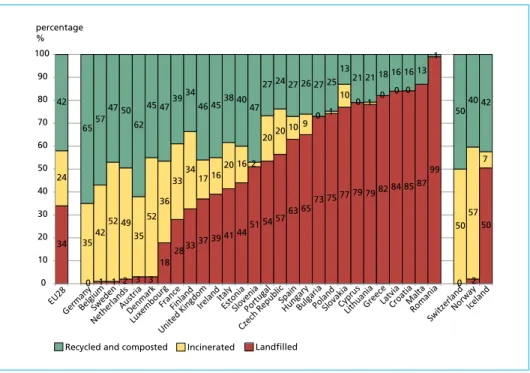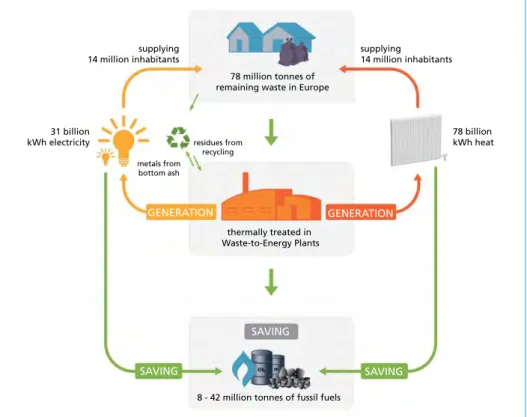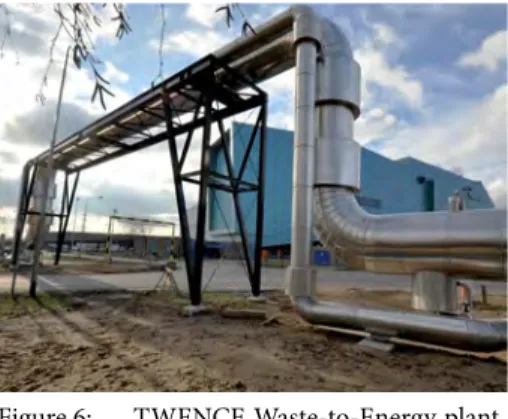Current developments in European Waste-to-Energy
Ferdinand Kleppmann
1. Diverting waste from landfills ...49
2. Helping Quality Recycling ...51
3. Metals and aggregates from bottom ash ...52
4. Sustainable Energy from Waste ...52
5. Waste-to-Energy plants’ contribution to the European economy ...54
6. Summary and outlook with regard to new waste targets ...54
7. References ...55
Waste-to-Energy Plants (waste incineration with energy recovery) thermally treat municipal and similar waste that cannot otherwise be reused or recycled in an envi- ronmentally or economically beneficial way, and generate energy from it.
Currently, there are some 450 plants in Europe (400 in EU 28) with a capacity of treating 78 million tonnes of municipal waste per year (72 million tonnes in EU 28).
Waste-to-Energy and Recycling have complementary roles in ensuring that high qua- lity recyclable materials are available to replace virgin materials within the economy.
Together they are also instrumental in diverting waste from landfills and reducing Greenhouse gas emissions.
In light of the European Commission’s recent proposals on the circular economy and particularly on the waste targets, the instrumental role Waste-to-Energy plays in closing the loop to a circular economy will be presented in this article.
1. Diverting waste from landfills
Over the last decade European States have been making progress in improving their was- te management systems, thanks to the waste management targets set in EU legislation.
Between 2002 and 2012 landfilling decreased by eighteen percent, recycling grew by eleven percent and incineration by seven percent. [2]
Figure 1: Municipal solid waste treatment in EU27 between 2002 and 2012
Currently, still more than eighty million tonnes of municipal waste are landfilled in the EU 28 each year, despite the major impact landfilling has on global warming.
2002 2003 2004 2005 2006 2007 2008 2009 2010 2011 2012 0
10 20 30 40 50 60 70 80 90 100
52 17
31 33 35 37 38 39 39 40 40 40 42
17 18 19 19 20 21 22 22 23 24
50 48 44 43 41 40 39 38 37 34
percentage
%
Recycled and composted Incinerated Landfilled
34
0 1 1 2 3 3 18
28 33 37 39 41 44 51 54 57 63 65
73 75 77 79 79 82 84 85 87 99
0 2 50 24
35 42 52 49 35
52 36
33 34 17 16
20 16 2
20 20 10 9 0 1
10 0 1 0 0 0
50 57
7 42
65 57 47 50 62
45 47 39 34 46 45 38 40
47
27 24 27 26 27 25
13 21 21 18 16 16 13 1
50 40 42
0 10 20 30 40 50 60 70 80 90 100 percentage
%
Recycled and composted Incinerated Landfilled
Figure 2: Municipal waste treatment in 2012 EU 28 + Switzerland, Norway and Iceland
Graph by CEWEP, Source: EUROSTAT 2012
This waste produces methane, a potent greenhouse gas, which is 25 times more si- gnificant in mass than CO2. 93 percent of all greenhouse gas emissions from waste management are caused by landfills [4].
When waste is used as a fuel in Waste-to-Energy facilities, the emission of methane from landfills is avoided and primary energy from power stations is substituted. The result is a decrease in the overall emission of greenhouse gases.
Waste which is not landfilled, but used for producing electricity and heat, therefore helps to reduce the emission of greenhouse gases.
From 6 countries in the EU 28 an important lesson can be learnt about how to reduce the amount of municipal waste landfilled to a minimum: Germany, Belgium, Sweden, the Netherlands, Austria and Denmark landfill 3 percent of municipal waste or less.
They have all introduced landfill bans and worked towards complementary waste ma- nagement systems where both Recycling and Waste-to-Energy play a role in diverting waste from landfills.
Landfill bans provided the legal certainty needed for investments in the necessary recycling and energy recovery infrastructure.
In cooperation with recycling, Waste-to-Energy Plants help Member States to divert waste that is not good enough for recycling from landfilling and use it to generate energy.
2. Helping Quality Recycling
Quality Recycling is key in order to enable industry and consumers to have greater confidence in recycled materials, and to actually use them. To develop Quality Recycling we need: accurate measurement, better data and transparency about what goes in and what goes out of Recycling plants.
Waste-to-Energy Plants act as a driver for Quality Recycling by treating polluted and complex waste, keeping harmful substances out of the Circular Economy. Sometimes materials are bonded and can be extracted only by means of thermal treatment.
Waste-to-Energy is a hygienic means of treating waste (destroying viruses and bacteria), which prevents polluted or degraded materials from entering the recycling-process and then into new products.
Greater transparency is also necessary in order to avoid that the EU’s recycling targets are met simply by shipping the waste to countries with poorer environmental and social standards than those in Europe.
For example, today about 50 percent of post-consumer plastic waste is used outside the EU 27+2 mainly in China and other Asian countries with little or no checks on how this material is then treated at the final destinations with regard to health and environmental implications [5].
The vital issue of Quality Recycling, rather than just focusing on quantity, should receive greater attention in the current revision of the EU waste targets.
3. Metals and aggregates from bottom ash
The combustion process cleans and separates metals and inerts from mixed waste, which could not otherwise be recycled. As a result further recycling of these metals is possible. Valuable parts of the bottom ash, which is the residue from the combustion process, collected at the end of the grate in a Waste-to-Energy Plant, can be recycled. For example, the remaining ferrous and non-ferrous metals in the waste can be extracted from the bottom ashes and recycled into new products such as aluminium castings for the automotive industry. Other remaining minerals can be used as secondary aggregates, e.g. in road construction or in building products.
Bottom ash represents the largest mass flow of residues from the thermal treat- ment of waste, accounting for 20 percent to 25 percent. The composition of bot- tom ash varies with the input of a Waste-to-Energy Plant. As a rule of thumb in 1 tonne of bottom ash there are the following main fractions: Mineral fraction 80 percent - 85 percent; Metals 10 percent - 15 percent; Non-ferrous metals 3 percent - 5 percent; Unburned material < 3 percent.
Due to the extra quantities of materials recovered from bottom ash Waste-to-Energy Plants contribute further to achieving a recycling society and help to improve Europe’s Resource Efficiency, using unavoidable waste as a valuable resource wherever possible.
4. Sustainable Energy from Waste
Waste-to-Energy Plants produce electricity, district heating or cooling for homes and businesses, and steam for industrial processes. They generate reliable, base-load, local energy, while at the same time providing vital waste services.
Considering that about 78 million tonnes of household and similar waste that remains after waste prevention, reuse and recycling, were treated in Waste-to-Energy Plants Figure 3: Indaver, Belgium Figure 4: Lauta WtE Plant, Germany
across Europe in 2012, 31 billion kWh of electricity and 78 billion kWh of heat can be generated.
This is enough energy to supply 14 million inhabitants with electricity and 14 million inhabitants with heat. This is the equivalent to the entire population of Denmark, Fin- land and Lithuania that can be supplied with electricity and heat throughout the year.
The heat and electricity from Waste-to-Energy Plants replaces fossil fuels used by con- ventional power plants. Waste-to-Energy Plants therefore help to reduce CO2 emissions.
Then between 8-42 million tonnes of fossil fuels (gas, oil, hard coal and lignite) emitting 8-42 million tonnes of CO2 can be substituted annually.
78 million tonnes of remaining waste in Europe
thermally treated in Waste-to-Energy Plants
8 - 42 million tonnes of fussil fuels SAVING
SAVING SAVING
GENERATION GENERATION
supplying 14 million inhabitants
supplying
14 million inhabitants
31 billion kWh electricity
78 billion kWh heat metals from
bottom ash
residues from recycling
Figure 5 : Waste-to-Energy cycle
Moving waste away from landfills to Recycling and Waste-to-Energy, as well as impro- ving grid access and infrastructure for energy supply from Waste-to-Energy Plants, would allow European Waste-to-Energy Plants to generate by 2020 potentially 196 billion kWh of sustainable energy. This is the equivalent amount of energy generated by 6-9 nuclear stations or 25 coal power plants.
About 50 percent of the energy produced by Waste-to-Energy Plants is renewable.
EU legislation considers the biodegradable fraction of municipal and industrial waste as biomass, and thereby a source of renewable energy.
Waste-to-Energy technology is one of the most reliable and effective alternative ener- gy options to reduce CO2 emissions and to save limited fossil fuel resources used by traditional power plants.
Waste-to-Energy Plants operate 24 hours a day, 7 days a week, 365 days per year. They supply reliable base-load energy to the electricity grid.
Considering that in 2012 the EU 28 imported 4 million TJ of natural gas from Russia (Eurostat), it is worth noting that the energy content of the waste treated by Waste- to-Energy Plants in the EU can substitute 19 percent of Russian gas imports (2012).
And Waste-to-Energy could contribute even more to security of energy supply:
There is a major opportunity to use more energy from waste in the form of heat, if the appropriate linking of heat (or process steam) customers to Waste-to-Energy Plants would be encouraged. Therefore drivers for improving infrastructure for district heating and cooling in addition to incentives to maximize electricity production from waste are needed.
Figure 6: TWENCE Waste-to-Energy plant, Netherlands
Studies suggest that the potential for using heat from waste is equivalent to 200 billion kWh per year by 2050, which means that there are still major opportunities for further development. Today, European Waste-to-Energy Plants supply some 50 billion kWh per year to district hea- ting networks, which accounts for about 10 percent of the total heat delivered through district heating systems.
In some European cities Waste-to-Energy Plants cover 50 percent or more of the local heat demand – at a very cost-effective price (e.g. costs for steam from Waste-to-Energy Plants in Paris are 1.63 c€/kWh versus 4.17 c€/kWh for gas (European average)).
5. Waste-to-Energy plants’ contribution to the European economy
Waste-to-Energy Plants create jobs – well paid, highly-skilled jobs in good, clean working conditions. We estimate that the average number of direct jobs created by a Waste-to-Energy Plant in Europe is 62. That means some 28,000 direct jobs and a further 28,000 indirect jobs, a total of 56,000 jobs, are created by Waste-to-Energy Plants across Europe.
6. Summary and outlook with regard to new waste targets
To avoid wasting natural resources and to reduce landfill methane emissions, combus- tible waste that is not suitable for recycling should not be landfilled, but treated in a more sustainable way in Waste-to-Energy Plants that produce energy from the waste.
The Commission’s proposal to phase out landfilling of recyclable wasteis a good step forward. However, to avoid wasting the 80 million tonnes of municipal waste that is still landfilled in the EU 28 each year, an earlier target of 2020 rather than 2025 would have been better.
A ban on landfilling will unleash the full potential of waste as a resource. This will increase recycling rates and energy generation from the remaining waste.
The Commission’s proposal to recycle 70 percent of municipal waste by 2030 (counting the output of final recycling facilities) is ambitious. However, the vital issue of Quality Recycling, rather than just focusing on quantity, should receive greater attention in the on-going revision of the waste targets.
In order to develop Quality Recycling, we need: better measurement and better data, as well as transparency and traceability of recycled materials.
Waste-to-Energy prevents dirty or contaminated waste from entering the recycling chain and adversely impacting quality. If waste is not good enough for recycling (e.g.
degraded after being recycled several times) it should be turned into energy by Waste- to-Energy Plants.
Concerns that diverting waste from landfills would just mean that it goes to Waste-to- Energy rather than being recycled are not justified as Quality Recycling and Waste- to-Energy are complementary options in order to divert waste from landfilling, and Waste-to-Energy capacity is needed to treat the residues from recycling facilities.
Currently, some stakeholders fear that overcapacities of Waste-to-Energy Plants will be created in Europe. Actually, a number of Northern European countries (e.g. Sweden, Netherlands, Germany and Denmark) have some spare capacities. However, at the same time they achieve high recycling rates and have practically phased out landfilling.
They are currently offering spare capacities in their highly efficient plants to countries that would otherwise landfill the waste. Ten EU-Member States have no or negligible Waste-to-Energy capacity and still rely heavily on landfill.
Considering that the municipal waste incineration rate is 24 percent, the EU as a whole is far from a point of overcapacity in Waste-to-Energy Plants. Also the Waste-to-Energy sector will not hamper ambitious recycling targets. However, the quality aspect of recycling should play a more significant role rather than the discussion being purely focused on quantitative targets.
7. References
[1] Commission proposal on the Waste Targets – http://eur-lex.europa.eu/legal-content/EN/
TXT/?uri=CELEX:52014PC0397 [2] EUROSTAT
[3] http://cewep.eu/information/energyclimate/warmthfromwaste/1115.Warmth_from_
Waste_A_Win-Win_Synergy.html
[4] UK GHG Inventory (UNFCCC coverage) (Ricardo-AEA, 2014) https://www.gov.uk/govern- ment/uploads/system/uploads/attachment_data/file/319501/Waste_2012.pdf
[5] Velis, C.: University of Leeds, http://www.cewep.eu/events/m_1233
Plant engineering with the environment in mind
General contractor, engineering partner, lot supplier
Thermal waste treatment plants are complex structures, the design of which differs in each individual case. The implementation of these plants requires highly competent engineering and plant construction specialists who cover the whole range of services from planning and supply to start-up and maintenance.
We have a vast range of experience as a general contractor for the supply of entire turnkey plants. Based on our combustion technologies and in cooperation with carefully selected and proven suppliers, e.g. for flue gas cleaning systems, energy utilization facilities, electrical engineering, control & instrumentation technology as well as construction services, we combine the various lots to create conceptually optimized plants. Moreover, we act as a lot supplier for the core area of the combustion system or perform engineering services for our cooperation partners.
Topics driving us and our systems
WASTE
FIRE
ENERGY
ENVIRONMENT


